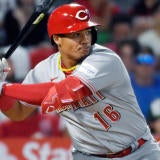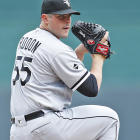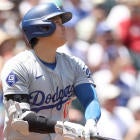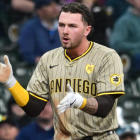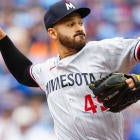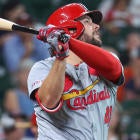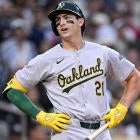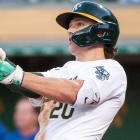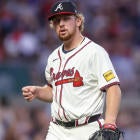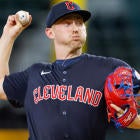Because the tails of the development curve are so long, your average baseball fan doesn’t know much about even the most hyped prospects coming into the draft every year. Whereas baseball or football prospects can be stars within months of being selected, the assumption for most draft picks is you won’t get to see them in the majors for two or three years, and that’s in a best-case scenario. There just isn’t any reason to familiarize yourself with them.
There are, of course, exceptions. Bryce Harper and Stephen Strasburg were household names as amateurs, and though he never reached quite those levels, plenty of baseball fans knew who Carlos Rodon was during his two stellar seasons at North Carolina State.
Rodon didn’t end up going No. 1 overall, and he wasn’t even the first member of his own draft class to make it to the majors -- Brandon Finnegan was up just months after being drafted -- but Rodon didn’t need much seasoning either. He threw just 38 innings in the minors before getting the call shortly after the start of the 2015 season, and the universal assumption from Day 1 was that it was only a matter of time before he would be an ace.
Things haven’t quite gone as smoothly as hoped for Rodon, at least so far. Though he has struck out north of a batter per inning in each of his first two seasons, Rodon has struggled with control and consistency, settling in as a roughly league-average pitcher over his first 304 1/3 innings. Rodon improved his control in his second major-league campaign in 2016, but his home run and hit rates both shot up, leading to a decline in ERA, from 3.75 to 4.04.
That isn’t exactly a sign that great things are in store for Rodon, and on the surface, it seems that he hasn’t really developed much from when he was drafted. In college, Rodon’s mid-90’s fastball and wipeout slider were more than enough to get through amateur lineups, but we’ve always known he needed more to get major-league batters out. A third pitch to counter righties is a necessity, but he has rarely shown much confidence in his changeup as anything more than a show-me pitch.
It shouldn’t come as a surprise, then, that Rodon has struggled mightily against right-handed batters. In 296 career plate appearances, lefties have a posted a .565 OPS against Rodon; he basically turns every left-handed batter into Curt Casali. Righties, on the other hand, have a robust .279/.355/.444 line against Rodon, comparable to what Hunter Pence has managed over the last two seasons. That’s a pretty significant gap, one that becomes even more glaring given that 77.7 percent of his career batters faced have been righties. It’s going to be hard for Rodon to live up to his potential if he can’t crack that nut.
The good news is that he seems to have started to figure it out last season. Rodon returned from a trip to the disabled list on July 31 with seven strikeouts over 6 1/3 innings and, though he struggled with home runs en route to allowing five earned, it was nonetheless the start of a pretty significant turnaround. From July 31 on, Rodon posted a 3.45 ERA with a 25.2 percent strikeout rate and a 7.2 percent walk rate, both of which are better than league average. What changed?
One answer might be that Rodon simply got healthy. He averaged 93.8 MPH on his fastball in his first 16 starts before going on the DL, but that number jumped up to 94.7 after the injury. He also seemed to gain more confidence in his curveball, upping its usage from just 6.2 percent prior to the injury to 16.7 afterward.
Nearly all of that increase came against right-handed batters as he remained almost entirely a two-pitch pitcher against lefties -- why fix what ain’t broke? He upped his changeup usage to 19.6 percent against right-handed batters, however, and though he didn’t have great results with it, it did help him be a bit less predictable. He actually threw his change 26 percent of the time on the first pitch to right-handed batters after the injury.
The results, as you can see here, were pretty dramatic, and they were almost exclusively tied to batter handedness:
Pre-injury, vs. RHB: 329 PA, .309/.376/.502, 21.0 K%, 9.1 BB%, 1.8 HR/9
Pre-injury, vs. LHB: 81 PA, .221/.263/.289, 27.2 K%, 2.5 BB%, 0.4 HR/9
Post-return, vs. RHB: 253 PA, .238/.307/.389, 24.5 K%, 7.5 BB%, 1.0 HR/9
Post-return, vs. LHB: 52 PA, .245/.288/.408, 28.8 K%, 5.8 BB%, 0.7 HR/9
Lefties are never going to have much success against Rodon, so he doesn’t really even need to dominate right-handed hitters to be a top-flight starter. He just needs to hold his own against them to be useful, and as we saw after the injury, if he can improve his results enough against them, he can take a big leap forward.
It isn’t all about the changeup, of course. The White Sox were the worst pitch-framing team in baseball last season, per Baseball Prospectus, and Dioner Navarro was the biggest culprit. He was gone for the last month of Rodon’s season, and Omar Narvaez could have stolen a few extra strikes here and there to Rodon’s benefit. Every little bit helps when you’re as close to stardom as Rodon appears to be.
Rodon showed very real signs of taking the leap toward stardom last season, and it wasn’t an accident. He was a different pitcher, and one who looks more and more like the potential ace everyone thought he would be when he got drafted. That he carries an ADP of just 182 with him only makes him even more valuable. If you’re looking for a potential ace in the middle rounds, Rodon’s chances look as good as any.





